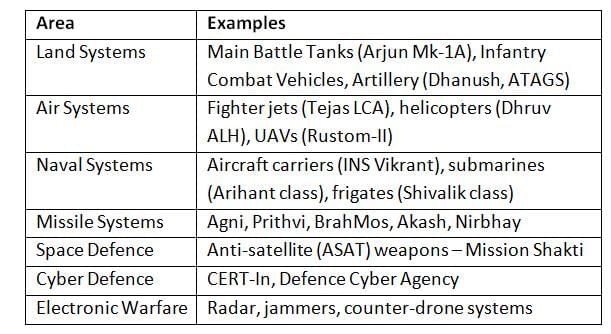UPSC Exam > UPSC Notes > Science & Technology for UPSC CSE > Cheat Sheet: Defence Technology
Cheat Sheet: Defence Technology | Science & Technology for UPSC CSE PDF Download
Introduction
Scientific & technological applications for national security, military capability, and strategic deterrence.
Includes weapons systems, surveillance, communications, space tech, cyber defence.
Key Areas

Indian Defence R&D & Production
- DRDO – Defence R&D organisation under MoD.
- OFB – Ordnance Factory Board (now corporatised).
- DPSUs – HAL, BEL, BDL, GRSE, MDL.
- Private Sector – Tata Advanced Systems, L&T Defence, Bharat Forge.
- Make in India – Defence – Focus on indigenisation & exports.
Missile & Strategic Systems
- Ballistic Missiles – Agni series (nuclear-capable), Prithvi series.
- Cruise Missiles – BrahMos (supersonic), Nirbhay (subsonic).
- Air Defence – Akash, Spyder, S-400 (procured from Russia).
- SLBMs – K-15 Sagarika, K-4 (submarine-launched).
- Anti-Satellite (ASAT) – Mission Shakti (2019).
Defence Technology Missions
- Integrated Guided Missile Development Programme (IGMDP) – 1983–2008, led to Prithvi, Agni, Akash, Nag, Trishul.
- Mission Shakti – ASAT capability.
- Ballistic Missile Defence (BMD) – Multi-layered interception.
- Unmanned Systems – UAVs (Nishant, Rustom-II), combat drones under development.
Emerging & Future Tech
- Artificial Intelligence in defence (autonomous systems, surveillance).
- Hypersonic missiles (HSTDV – Hypersonic Technology Demonstrator Vehicle).
- Directed Energy Weapons (lasers, microwaves).
- Quantum communication for secure military networks.
- Swarm drones.
- 3D printing of defence components.
Defence Space & Cyber
- Defence Space Agency (DSA) – Integrates space-based assets.
- GSAT-7 series – Military communication satellites.
- Cyber Defence – Defence Cyber Agency (tri-service).
- Satellite Navigation – NAVIC (Indian GPS alternative).
International Cooperation
- Joint development – BrahMos (India–Russia), Barak-8 (India–Israel).
- Strategic imports – Rafale jets (France), S-400 systems (Russia).
- Defence Exercises – Malabar, Yudh Abhyas, Varuna, Garuda Shakti.
Challenges
- Dependence on imports (esp. jet engines, advanced radars).
- Technology gaps in stealth, UAV endurance, AESA radar.
- Export competitiveness.
- Cybersecurity vulnerabilities.
The document Cheat Sheet: Defence Technology | Science & Technology for UPSC CSE is a part of the UPSC Course Science & Technology for UPSC CSE.
All you need of UPSC at this link: UPSC
|
90 videos|490 docs|209 tests
|
FAQs on Cheat Sheet: Defence Technology - Science & Technology for UPSC CSE
| 1. What are the key areas of focus in Indian Defence Research and Development (R&D) and production? |  |
Ans. The key areas of focus in Indian Defence R&D and production include missile and strategic systems, defence technology missions, emerging and future technologies, defence space and cyber capabilities, and international cooperation. These areas are crucial for enhancing India's defence capabilities and ensuring national security.
| 2. How does India approach missile and strategic systems development? |  |
Ans. India approaches missile and strategic systems development through a combination of indigenous research and development, collaboration with international partners, and leveraging advancements in technology. The emphasis is on developing a range of missile systems, including tactical and strategic missiles, to strengthen deterrence capabilities and enhance operational effectiveness.
| 3. What are the current emerging and future technologies in defence that India is focusing on? |  |
Ans. Emerging and future technologies in defence that India is focusing on include artificial intelligence, robotics, cyber warfare capabilities, hypersonic technologies, and advanced materials. These technologies are expected to revolutionize defence operations and improve the efficiency and effectiveness of military capabilities.
| 4. What role does international cooperation play in India's defence technology landscape? |  |
Ans. International cooperation plays a significant role in India's defence technology landscape by facilitating knowledge sharing, joint development of systems, and access to advanced technologies. Collaborations with other countries enhance India's capabilities in various domains and support indigenous efforts in defence production.
| 5. What are some challenges faced by India in defence technology and production? |  |
Ans. Some challenges faced by India in defence technology and production include bureaucratic hurdles, reliance on imports for critical technologies, the need for greater private sector participation, and the urgency to innovate and keep pace with global advancements. Addressing these challenges is essential for achieving self-reliance in defence.
Related Searches
















